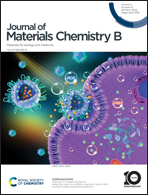Supramolecular detoxification of nitrogen mustard via host–guest encapsulation by carboxylatopillar[5]arene†
Abstract
Nitrogen mustard (NM), a kind of alkylating agent similar to sulfur mustard, remains a threat to public health. However, there is nearly no satisfactory antidote for nitrogen mustard. Herein, we developed a supramolecular antidote to nitrogen mustard through efficient complexation of NM by carboxylatopillar[5]arene potassium salts (CP[5]AK). The cavity of methoxy pillar[5]arene (P5A) is sufficient to encapsulate NM with an association constant of 1.27 × 102 M−1, which was investigated by 1H NMR titration, density functional theory studies and independent gradient model studies. NM degrades to the reactive aziridinium salt (2) in the aqueous phase which irreversibly alkylates DNA and proteins, causing severe tissue damage. Considering the size/charge matching with toxic intermediate 2, water-soluble CP[5]AK was selected to encapsulate the toxic aziridinium salt (2), resulting in a high association constant of 4.10 × 104 M−1. The results of protection experiments of guanosine 5'-monophosphate (GMP) by CP[5]AK indicated that the formation of a complex could effectively inhibit the alkylation of DNA. Besides, in vitro and in vivo experiments also indicated that the toxicity of the aziridinium salt (2) is inhibited with the formation of a stable host–guest complex, and CP[5]AK has a good therapeutic effect on the damage caused by NM. This study provides a new mechanism and strategy for the treatment of NM exposure-induced skin injuries.
![Graphical abstract: Supramolecular detoxification of nitrogen mustard via host–guest encapsulation by carboxylatopillar[5]arene](/en/Image/Get?imageInfo.ImageType=GA&imageInfo.ImageIdentifier.ManuscriptID=D2TB02211G&imageInfo.ImageIdentifier.Year=2023)


 Please wait while we load your content...
Please wait while we load your content...